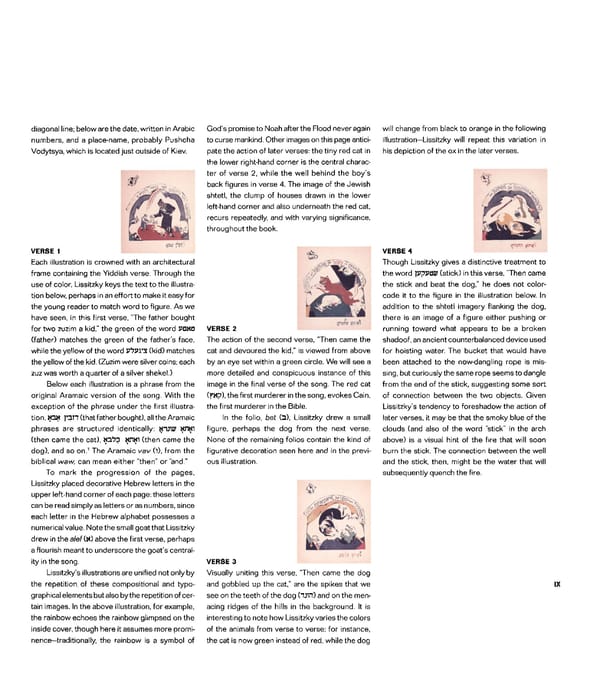diagonal line; below are the date, written in Arabic God's promise to Noah after the Flood never again will change from black to orange in the following numbers, and a placename, probably Pushcha to curse mankind. Other images on this page antici illustration—Lissitzky will repeat this variation in Vodytsya, which is located just outside of Kiev. pate the action of later verses: the tiny red cat in his depiction of the ox in the later verses. the lower righthand corner is the central charac ter of verse 2, while the well behind the boy's back figures in verse 4. The image of the Jewish shtetl, the clump of houses drawn in the lower lefthand corner and also underneath the red cat, recurs repeatedly, and with varying significance, throughout the book. VERSE 1 VERSE 4 Each illustration is crowned with an architectural Though Lissitzky gives a distinctive treatment to frame containing the Yiddish verse. Through the the word ]Vp9QW (stick) in this verse, "Then came use of color, Lissitzky keys the text to the illustra the stick and beat the dog," he does not color tion below, perhaps in an effort to make it easy for code it to the figure in the illustration below. In the young reader to match word to figure. As we addition to the shtetl imagery flanking the dog, have seen, in this first verse, "The father bought there is an image of a figure either pushing or for two zuzim a kid," the green of the word PQ8Q VERSE 2 running toward what appears to be a broken (father) matches the green of the father's face, The action of the second verse, "Then came the shadoof, an ancient counterbalanced device used while the yellow of the word P^PPX (kid) matches cat and devoured the kid," is viewed from above for hoisting water. The bucket that would have the yellow of the kid. (Zuzim were silver coins; each by an eye set within a green circle. We will see a been attached to the nowdangling rope is mis zuz was worth a quarter of a silver shekel.) more detailed and conspicuous instance of this sing, but curiously the same rope seems to dangle Below each illustration is a phrase from the image in the final verse of the song. The red cat from the end of the stick, suggesting some sort original Aramaic version of the song. With the (f8p), the first murderer in the song, evokes Cain, of connection between the two objects. Given exception of the phrase under the first illustra the first murderer in the Bible. Lissitzky's tendency to foreshadow the action of tion, 828 pan (that father bought), all the Aramaic In the folio, bet (1), Lissitzky drew a small later verses, it may be that the smoky blue of the phrases are structured identically: 8U1B? 81181 figure, perhaps the dog from the next verse. clouds (and also of the word "stick" in the arch (then came the cat), 83^3 8TI81 (then came the None of the remaining folios contain the kind of above) is a visual hint of the fire that will soon 1 burn the stick. The connection between the well dog), and so on. The Aramaic vav (l), from the figurative decoration seen here and in the previ biblical waw, can mean either "then" or "and." ous illustration. and the stick, then, might be the water that will To mark the progression of the pages, subsequently quench the fire. Lissitzky placed decorative Hebrew letters in the upper lefthand corner of each page: these letters can be read simply as letters or as numbers, since each letter in the Hebrew alphabet possesses a numerical value. Note the small goat that Lissitzky drew in the alef (8) above the first verse, perhaps a flourish meant to underscore the goat's central ity in the song. VERSE 3 Lissitzky's illustrations are unified not only by Visually uniting this verse, "Then came the dog the repetition of these compositional and typo and gobbled up the cat," are the spikes that we IX graphical elements but also by the repetition of cer see on the teeth of the dog (TJin) and on the men tain images. In the above illustration, for example, acing ridges of the hills in the background. It is the rainbow echoes the rainbow glimpsed on the interesting to note how Lissitzky varies the colors inside cover, though here it assumes more promi of the animals from verse to verse: for instance, nence—traditionally, the rainbow is a symbol of the cat is now green instead of red, while the dog
 Had Gadya The Only Kid: Lissitzky 1919 Page 10 Page 12
Had Gadya The Only Kid: Lissitzky 1919 Page 10 Page 12